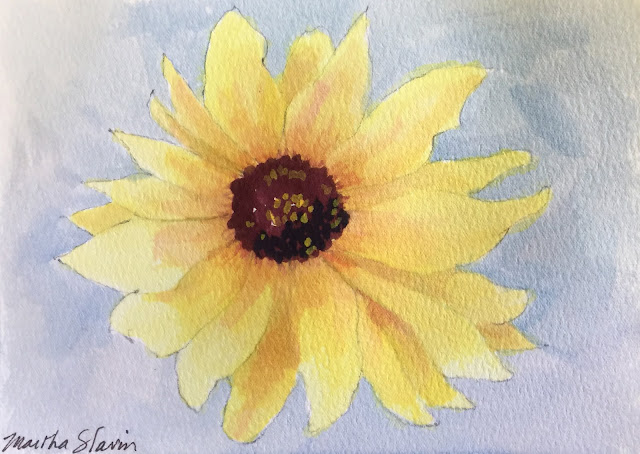We all get stuck sometimes, don't we?
Artists and writers sometimes confront the blank white page and freeze. As an artist, I know I can get past that blank page. I have found several ways to help myself. I wash a light yellow over an entire piece of watercolor paper. With a pen, I draw connected circles back and forth across the page just as I did when I was learning how to write. I write my name backwards in big letters. I get up and take a break. Little tricks that might get my mind working creatively. I use those art exercises when I need to loosen up to write. My first question to myself every Monday: what could I write about this week? Some weeks I know right away, other weeks I will start with one thought which will morph into a hundred different ideas.
If I'm really stuck, I participate in a 30-day challenge to re-ignite creativity through practice, practice, practice. If you Google 30-day art or writing challenges, you will find lots of good ideas to help you jumpstart your day. Doodlewash presents a Watercolor Monthly with lists of things to paint or draw. In October, Jake Parker encourages artists to draw with pen and ink for Inktober. November is Writers Month. The challenge there is to write a 50,000-word novel in a month. For something less daunting right now, fellow blogger, Chandra Lynn from Pics and Posts lists ideas that could inspire you to dig deep into your reservoir of potential subjects. She got me thinking because I love lists too.
I asked myself, "What are three things I always carry and that I actually use?
I couldn't hone it down to just three, but it was an interesting exercise to discover which small things become essential.
Lip Balm
Pencil or Pen
Smallest Art Journal that fits in my purse. The journal has become my COVID diary of my appointments and the other people I see there.
Phone/camera
Then I thought of all the things I put in my car's trunk that I've either forgotten about or never use, and knowing that if I remove them, I will need them the very next day.
Sunscreen
Change
Animal alarm for my walks just in case I run into a mountain lion (we all have unusual fears, don't we?) In my defense, we have had sightings of bobcats in our neighborhood, but I never remember the alarm.
My complete art kit, including a sketchbook, pencils, pens, water brush, colored pencils, eraser. Somehow I forget to take it with me and wish I had something to sketch with. That's why I carry my camera.
Water to drink and to fill my water brush.
The discount coupons from my favorite garden store that I forget to bring with me into the store.
Sunscreen. And I was born and still live in California.
What do you bring with you?
Check out these websites for good ideas to break the blank white page:
https://doodlewash.com/watercolor-art-challenges/
https://lindahoye.com/author/lindahoye/














